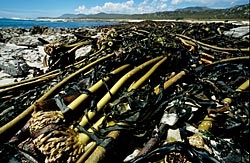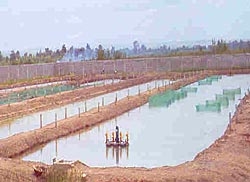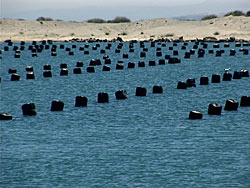| |
|
 |
|
Aquaculture: The Science of Aquaculture |
There is a range of different types of aquaculture depending on what is being reared and on the farming methods used.
 Algaculture Algaculture
Farming of seaweed/kelp and other algae species which have commercial and industrial uses is called algaculture. For centuries seaweed has been used as a source of potassium for the manufacture of potash (an impure form of potassium carbonate mixed with other potassium salts) and potassium nitrate.
Farming of the Ecklonia maxima kelp species allows a large number of plants to be grown in a small area. This is of some advantage because harvesting of plants in the wild under normal circumstances will require one to travel long distances to find the right species and investigate the quality of plants.
Kelp constitutes the major feed for the farmed abalone in South Africa, in some cases in tank cultures whereby seaweed and abalone are grown in integrated systems. The major uses of kelp are:
- In great amounts, kelp ash can be used for glass and soap production.
- Alginate, a kelp derived carbohydrate, is used to thicken products such as ice cream, jelly, salad dressing and toothpaste. It is also used as an ingredient in exotic dog food and in manufactured goods.
- Seaweed is an important source of natural vitamins and minerals, including essential trace minerals.
Taurus Atlantic Seaweeds is a company involved in seaweed farming in Lüderitz, Namibia.
 Fish farming Fish farming
Fish farming is the principal form of aquaculture, while other methods may fall under mariculture. Farming is done under intensively controlled conditions, where the feed is essentially provided by the farmer. Within the intensive and extensive aquaculture methods, there are numerous fish production methods, and each has applications unique to its design.
a. Integrated recycling systems: Basically, large plastic fish tanks are placed in a greenhouse, with a hydroponic bed placed near, above or between them. When Tilapias are raised in the tanks, they are able to eat algae, which naturally grow in the tanks when the tanks are properly fertilised. The water tank is slowly circulated to the hydroponic beds where the Tilapia waste feeds commercial plant crops. Carefully cultured microorganisms in the hydroponic beds convert ammonia to nitrates, and the plants are fertilised by the nitrates and phosphates.
b. Irrigation ditch or pond systems: These are irrigation ditches or farm ponds in which fish are raised. The basic requirement is to have a ditch or pond that retains water, possibly with an above-ground irrigation system (many irrigation systems use buried pipes with headers).
c. Cage system: In this system, fish are kept in cages, made from synthetic fibre, and are kept in existing water resources to hold and protect fish until they can be harvested. Some of the advantages of fish farming with cages are: many types of water systems can be utilised (e.g. rivers, lakes, filled quarries etc.); many fish species can be raised; and fish farming can co-exist with sport fishing and other water uses.
d. Classic fry farming: Trout and other sport fish are often raised from eggs to fry or fingerlings stage and then trucked to streams and released.
 Mariculture Mariculture
Mariculture basically refers to farming of marine species. This is a specialised branch of aquaculture involving the farming of marine organisms for commercial purposes in the open ocean, an enclosed section of the ocean, or in tanks, ponds or raceways which are filled with seawater.
Mariculture can be practised in the following ways:
1. Construction of sea-based farms where fish are penned in floating cages made of netting and anchored in the shallow coastal zone.
2. Construction of sea-based farms in which fish are penned in submerged cages made of netting and anchored in water of variable depth but are usually relatively close to the coast for ease of access. The environmental impact of submerged cages can be low as they can be located in waters of sufficient depth and exposure to facilitate the dispersal of wastes.
3. Construction of land-based farms that rely on a continuous replacement of seawater on the farm from the sea or an estuary. This method allows considerable scope to eliminate many of the environmentally deleterious effects of aquaculture.
Several companies have developed cages that can withstand extreme conditions (such as wave action). These include: Farmocean, Dunlop, Bridgestone, Oceanspar, Net Systems and Polar Circle.
Marine culture production worldwide is growing at the rate of about 5 to 7 percent annually. Further technical information on mariculture can be found here.
Integrated aquaculture-agriculture systems
Experience has demonstrated that aquaculture can be integrated with agriculture. This has been done through the farming of chicken and fish in one system, with chicken being raised over or adjacent to the ponds. In this practice chicken are raised for meat (broilers) and for eggs (layers), while at the same time the poultry excreta is recycled to fertilise the fishponds. This is of advantage, as it reduces costs on fertilizers and feeds in fish culture, hence maximizing benefits. Read more here.
Other advantages of such a system are:
- The pond embankment can be used for raising vegetables (agriculture).
- The nutrient-rich water from the fish ponds can be used to irrigate the vegetable crops.
- As fish will feed on the chicken excreta, costs of pelleted fish feeds which contained fish meal from marine fish resources are reduced.
If ducks are raised over the fishponds instead of chickens, the system will have the following advantages:
- Ducks will fertilise the pond with their droppings, resulting in a complete saving on pond fertiliser and supplementary fish feed, which accounts for a high proportion of costs in conventional fish culture.
- Ducks help release nutrients from the soil by loosening the pond bottom with their dabbling, and they also help to keep water plants in check.
- Ducks reared in this way need very little feed. As they usually feed on aquatic weeds, larvae, insects, earthworms, farmers can give the ducks kitchen waste.
A note on stocking density
Stocking density refers to the number or biomass of fish stocked per unit area or volume. The true stocking density for every aquarium is different and extremely complicated to calculate.
According to an aquaculture expert, Mr Leslie Ter Morshuizen of Aqua Africa (info@aquaafrica.co.za), choosing an appropriate stocking level should be based on a balance between what is biologically appropriate for the species being cultured, and what is technically feasible with the infrastructure being used and who is responsible given the skills level of the management and staff.
He further states that the model which holds much promise for aquaculture development in Africa is the Satellite Grower concept. It is designed in such a way that the technical skills for aquaculture primarily exist within the hub, which is the technically competent and experienced commercial partner.
The rearing of fish is said to require fair amounts of space and manpower, but is relatively less demanding in terms of practical skills, making it suitable for outsourcing to less experienced entities as growers. Once the fish attain table/ market size they are sold collaboratively, enabling the best prices to be obtained and maintaining a healthy market share.
The growers also benefit by buying supplies in bulk, hence benefiting from lower prices obtained through leverage.
|
|
|